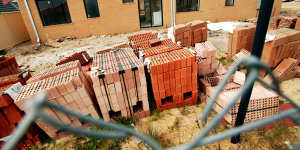The houses are often lauded for their “good bones” that were built to last but are they a superior construction compared to today’s modern project homes?

Are homes built better today? Well,it’s not a simple yes or no. Industry experts have their say.Erin Jonasson
Architect Antony DiMase said the structural componentry of the houses of yesteryear were generally built to high standards.
“From the 1930s to the mid-80s houses were built pretty well in terms of bricks,windows,footings,tiled roofs,and we used old-growth timbers,” he said.
“It was labour-intensive but the structural componentry of the homes were good and had fairly simple electrics and good plumbing.”
However,DiMase said the current housing marketplace was filled with cheap,poorly designed and constructed products – including those that claim to be sustainable.
“I think design and attention to the craft of building has been somewhat diminished ... everyone is in a mad rush to make money.”
Architect Antony DiMase
And some qualitative issues arising in new builds were due to a lack of cooperation and coordination by on-site trades.
“There are a lot more specialty trades out there who tend to work in isolation,” DiMase said.
“The three licensed trades on site,the plumber,electrician and builder,have a tough job coordinating a multitude of trades many of which aren’t licensed and regulated such as painters.
“It’s easy for them to get in and out if they just want to get paid.”
DiMase said what had changed over the decades is the level of care and pride in building and designing a new home.

Architect Antony DiMase,left.Supplied
“When you look at an older building you do see pride in the build that you don’t necessarily see today,” he said.
“It could be substantially better but it’s a shame for many companies it is all about turnover.
“I think design and attention to the craft of building has been somewhat diminished and that is partly due to economics,everyone is in a mad rush to make money.
“It’s fast architecture.”
But when it came to building materials and industry regulation,DiMase said that had changed for the better,with asbestos one key product resigned to the proverbial scrap heap.
“If you look at contemporary buildings from the ’90s to now,we see the rise of technology,more considerations for sustainability such as double-glazing and insulation and more emphasis on lifestyle with theatre rooms,a jacuzzi,air-conditioning,” he said.
“It’s almost a house that needs to be plugged in.”
Building inspector James Lawrence has seen the good,bad and the ugly inspecting hundreds of homes over the past three decades.
While he said it was a “toss of the coin” whether older homes were constructed according to the Australian standards of the time,“what held these old girls together was the hardwood”.
“One of the problems with modern residential construction is that the materials are getting more lightweight and trades are taking more shortcuts because of the tough building climate we’re in,” Lawrence said.
Barefoot Renovations owner Mark Hughes has renovated dozens of homes from the ’80s.
He said it was possible some houses built today wouldn’t stand the test of time,but they had the advantage of being subject to more rigorous building standards.
Quality of workmanship was an issue Hughes came across often in modern project homes.

Mark Hughes,owner of Barefoot Renovations.Supplied
“There is a churn-and-burn mentality,and you often don’t get that same level of pride in the construction,” he said.
“There’s not that level of passion you often saw in decades gone.
“One of the problems is that supervisors of large building companies often have 30 jobs to oversee,it’s impossible to supervise them all properly.”
Hughes said homes built in the ’70s and ’80s were generally good quality and had desirable features such as higher ceilings and ornate fixtures that gave the home character.
“Now many modern project homes don’t have a lot of character or soul,but on the plus side you do also get an awful lot of property for $200,000 with project homes,” he said.
“If you want better quality you need to pay more.”
Urban Development Institute chief executive Tanya Steinbeck said in Western Australia,the home building industry had been traditionally dominated by double-brick construction.
These established homes had the advantage of often being in a choice location in well-established communities with essential services and potentially higher land values.
“We would suggest getting professional advice on any areas that need consideration in terms of an older home prior to purchase,” she said.
“Any improvements and ongoing maintenance requirements are best considered up front so that you can include in your budget accordingly.”
Steinbeck said new homes had the advantage of being guided by more stringent building regulations which are regularly updated to ensure continual improvement in standards of sustainability,including energy efficiency and water saving technologies.
WA Housing Industry Association deputy executive director Phil Vaughan said today there was a much bigger range of building materials available to choose from.
“Over 40 years,manufacturers have created new innovative products that are faster to use,easier to work with,and have better sustainability properties,” he said.
“Almost every building material has been transformed to be more environmentally friendly in production and performance.”
Vaughan said apprentice numbers have grown over the last few years due to demand and incentives,and it was vital they were retained to maintain and grow the stock of qualified trades.
The Morning Edition newsletter is our guide to the day’s most important and interesting stories,analysis and insights.